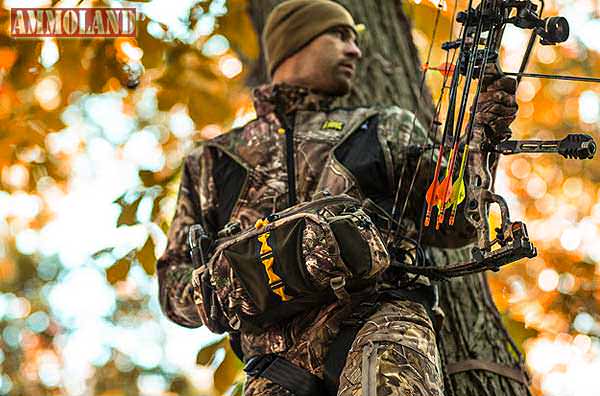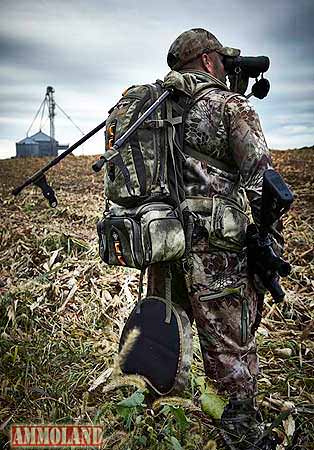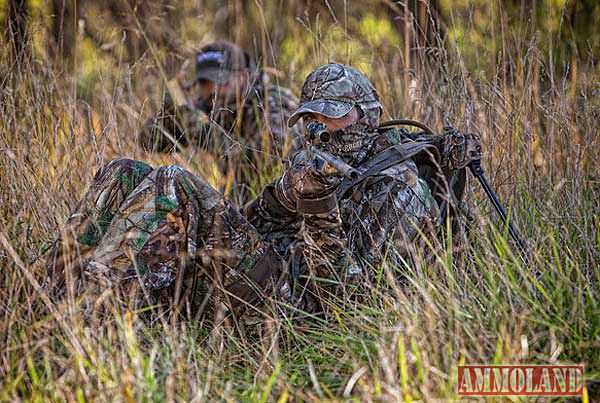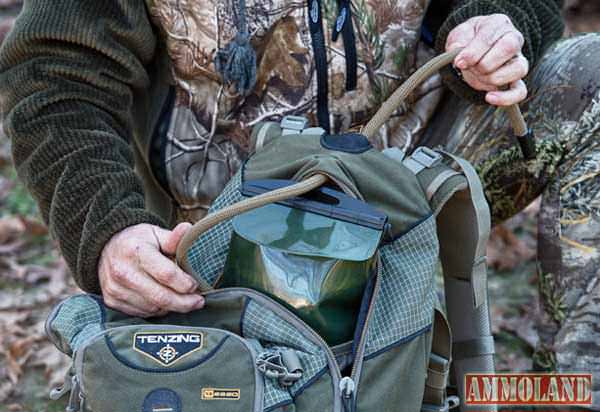
PLANO, IL -(Ammoland.com)- A hunting pack is a fundamental piece of gear. Even the most spartan hunter has a bevy of core equipment and supplies they need to transport to and from the field.
A gadgeteer has even more gear and will require much more from a pack in terms of its capacity and organizational capability.
In addition to one’s proclivity for gadgets and technology, what and how he or she hunts also plays a significant role in determining their ideal hunting pack.
So, where does one begin?
Look at hunting pack selection as a three-step process. First, consider five fundamental hunting pack designs. Choose the style that best suits the way you’ll hunt. Next, factor in your needs as they relate to overall capacity and choose the right size. Finally, but equally important, consider features that increase comfort and functionality.
Traditional Backpacks
A traditional backpack is what most envision when thinking of a hunting pack. It’s worn on the back and is supported with shoulder straps, which should be fully adjustable to modify the pack’s fit based on the wearer’s unique physique and the particular load being carried. The best models also have a fully adjustable waist belt system and at least one chest strap for increased comfort and load balancing.
Traditional backpack-style hunting packs come in many sizes, from less than 1,000 cubic inches to over 6,000 inches of total capacity. They typically contain at least one main compartment, which may include additional sub compartments to keep gear organized. Additional pockets or pouches may exist on the front and sides of the pack for added utility. Other additions may include D-rings, compression straps or other mechanisms for attaching additional pieces of gear to the pack’s exterior. The best hunting models will also include a dedicated spot to safely carry a firearm or bow.
Traditional backpacks may be constructed over a rigid frame of aluminum or, in some cases, carbon fiber. Packs lacking some kind of interior frame or internal stiffening components are less expensive, but will also be less comfortable to wear, as a frame helps support and distribute whatever load is being carried. Frame packs, or those supported with stiffening splines, are a necessity for backcountry hunters who use their packs to carry an abundance of gear, game quarters or capes.
Traditional backpack-style packs are the kings of capacity and load carrying, and are typically favored by big game hunters. The design is one of the most restrictive with respect to upper body mobility, however, and may hamper the wearer’s ability to shoulder a firearm or draw a bow. This may be of little consequence to the tree stand or blind hunter, however, who typically takes his or her pack off when settling in and hangs it on a nearby limb or hook.

Waist Packs
A waist pack is a great grab-and-go option for the stand or blind hunter, for archers, or for anyone who wants to travel light without an abundance of unnecessary gear or supplies.

By definition, these packs are worn around the waist and include at least one main compartment.
They may also include side pockets, D-rings, or other specialized pouches for carrying knives, rangefinders, ammunition or other essentials.
The waist pack’s belt system is of critical importance, as it’s the sole means of support for the pack’s weight.
Look for models with a wide, padded and fully adjustable waist belt and durable buckle that won’t loosen under a load.
Some waist packs offer additional functionality beyond load carrying. The TZ 721 model from Tenzing is designed for core warmth; with an integral hand muff and built-in pockets inside the waist belt to accept chemically activated hand-warmer pouches – a thoughtful and welcomed feature for stand and still hunters.
Lumbar Packs
A lumbar pack can be described as a hybrid of the traditional backpack and waist pack designs, and is a superior option for bowhunters, horseback hunters, or anyone who needs or appreciates full upper body mobility.
A lumbar-style hunting pack carries its load low around the waist like a waist pack, but is also supported by shoulder straps or a shoulder yoke. The design minimizes binding between the shoulders and allows archers a comfortable and unrestricted draw.
Capacities are generally significantly larger than those of waist packs, with most models providing a variety of compartments and pockets with up to about 1,500 cubic inches of total interior space.
Lumbar packs are a relatively complex design. Key features to look for include full adjustability of all waist, shoulder and chest straps, along with quality components and materials that improve durability and comfort.
Vests
A traditional preference for upland game and turkey hunters, the hunting vest is more garment than pack. Nonetheless, it’s designed to carry ammunition, electronics, calls and other essential gear, in addition to harvested game, and is a mainstay in most hunters’ wardrobes.
Standard upland hunting vest features include front pockets with built-in shot shell loops and a large rear game pouch. Turkey models may also include specialized pockets for calls and other gear. Materials cover the gamut, from inexpensive Nylon to oiled cotton to modern Dyneema-reinforced ripstop cotton.
As with other types of packs and hunting accessories, prices rise as features increase. Premium models are available in multiple sizes, include high-tech materials, fully adjustable waist belts and chest straps, and various pockets and compartments for specialized gear.

Chair Packs
Chair-style packs represent a relatively new hunting pack category, ranging from simple but well-engineered folding chairs with built-in shoulder straps to more advanced hunting backpacks with fold-out legs and drop-down, padded seats.
Chair-style packs are exciting options for turkey, predator, hog and even deer and elk hunters – anyone who hunts from the ground, needs to remain mobile and set-up quickly.
Capacities and designs vary, but two of the more advanced are Tenzing’s TZ TP14 Turkey Pack and TZ PP15 Predator Pack. Both utilize an aluminum frame stay backpack design with adjustable, foldout aluminum legs and a drop-down padded seat. The Turkey Pack incorporates a variety of specialized call and accessory pockets on its front and a large, expandable turkey pocket on its back. The Predator Pack is more generalized, sporting 2,200 cubic inches of storage space in a true backpack with main and sub compartments, a separate detachable electronics or accessory pack, and zippered front/side compartments with centerfire cartridge and shot shell loops, and a foldout boot to carry a firearm.
Pick Your Pack
Regardless of design category, today’s hunting packs range in price from as little as $30 to as much as $900. As one can imagine, price is a direct reflection of features, size, comfort and quality of construction. Packs with quality zippers, thread, advanced high performance materials, full adjustability and extra features like hydration systems, compression straps and rain covers represent the top of the market. Plan on spending $60 to $220 for a quality traditional hunting daypack that will hold up and perform for several seasons. Quality backcountry hunting packs capable of carrying capes, quarters or a week’s worth of gear start at around $200.
At least two truths become evident when researching and shopping for hunting packs today. First, the range of styles, features and choices has never been better. More options are available across multiple price points than ever before. Second, no single hunting pack excels in every hunting situation. Most avid hunters have multiple packs, so save your pennies, buy the highest quality, best-fitting packs you can afford, and take care of them. They’ll take care of you, and you’ll be money ahead in the long run.

About Tenzing
First introduced at the Archery Trade Association (ATA) Show in January 2012, the Tenzing™ line of innovative, high-tech, high performance packs are engineered and built to help hunters go farther, stay longer, and comfortably carry incredible loads in and even bigger ones back out.
Tenzing packs are constructed from the finest materials available, including the world’s strongest fiber, Dyneema®, and designed to be the lightest, most rugged, best organized and most versatile packs on the market. Tenzing packs are fully adjustable to result in a perfect fit for any hunter.
Combining his life-long passion for the outdoors with a relentless desire to be the best at his craft, Jay Robert is the soul and spirit behind the Tenzing brand. A company of hunters who listen to other hunters, Tenzing pursues innovation through real world product feedback from one of the hardest-working hunting pro and field staffs in the industry.
The ever expanding Tenzing product lineup includes carbon fiber frame packs, full-sized backpacks, lightweight day packs, lumbar packs, archer’s packs, women’s-fitted packs, turkey packs, upland bird packs, waterfowl blind bags, high-performance bow cases, gun cases and related accessories.
Tenzing products have received numerous recognitions for innovation and quality, including a prestigious Field & Stream Best of the Best 2012 Award for the Tenzing TZ 2220.
Learn more at www.tenzingoutdoors.com.



The lady with the just the head, isnt that kinda what they do to elephants?